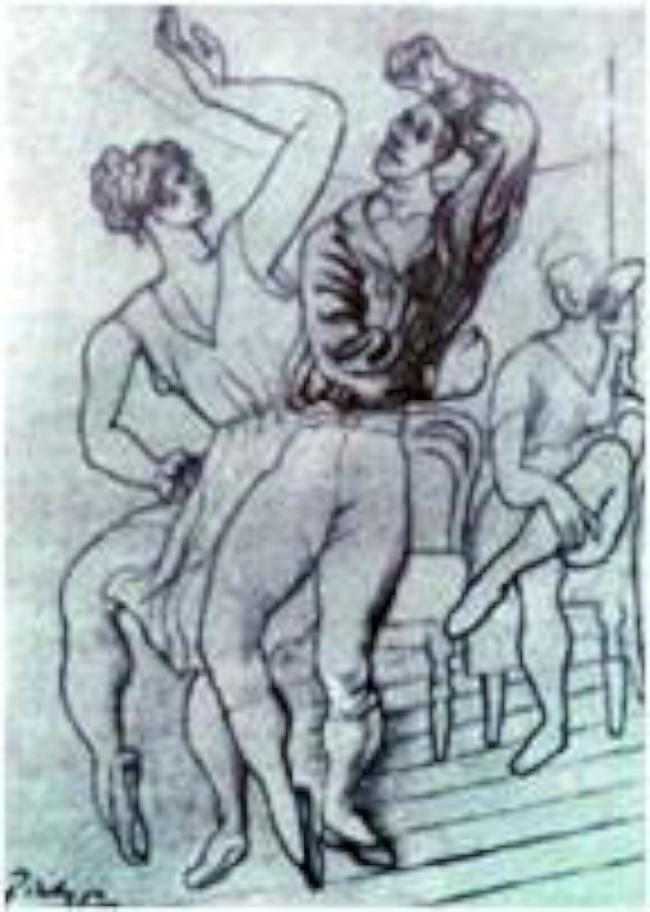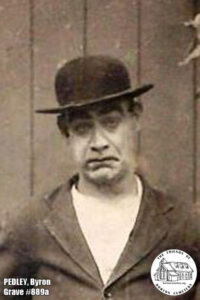b. 1893 – d. 1941 – Flamenco Extraordinaire
Félix García’s full name was Félix Fernández García, the García part coming from his mother´s maiden name.
Félix, famed Spanish dancer, and subject of Picasso, was confined at the Long Grove asylum, after he started acting peculiar, soon after being possibly deceived by The Ballet Russes director, Sergei Diaghilev. His life has been written by many authors, and in my opinion, quite a bit of rumour has slipped in as supposed fact.
Félix’s year of birth, 1893, is assumed from two records. His age (twenty-four) stated in the contract he signed with Diaghilev on November 1917, and his death record from Long Grove asylum which states he was 48 in 1941.
Félix’s rise to fame and his fall can be contributed to The Ballet Russes, without which we may never have heard of him. There is little documentation on his life before the Ballet Russes.
Spain’s greatest composer, Manuel de Falla took The Ballet Russes‘ director Sergei Diaghilev and choreographer Massine to see the best flamenco dancers in the city. Massine and Diaghilev travelled around Spain, absorbing the music and dance and working together on a new production, El sombrero de tres picos, ‘The Three Cornered Hat’.
Félix, a young and brilliant Spanish dancer from Seville, was hired by Léonide Massine in 1917, aged 24. Massine wished for Félix to teach some of the amazing ‘farruca’ footwork and Spanish ‘peasant music’ rhythm to the company. It is said (but unconfirmed) that Fernandez-García was promised the lead role as ‘The Miller’ in the new production of ‘The Three Cornered Hat’ by Diaghilev (who may well have taken Félix as a lover), and Félix travelled with the troupe to London in August 1918. They performed at the Coliseum in London until March 29, 1919.
In April 1919, the Ballet Russes were rehearsing at The Alhambra Theatre, with the season beginning on April 30. Pablo Picasso re-joined the company to create the sets and costumes in the first days of May 1919. It is rumoured that the roles of The Miller and Miller’s wife were to be performed by Félix García and Lydia Sokolova.

The only known impression of Félix is a 1919 hand drawn sketch by Pablo Picasso, of Félix ‘el Loco’ (crazy) dancing with Russian ballet dancer Vera Nemtchinova. This drawing can be pinpointed to have been drawn between 1st-7th May 1919.
Diaghilev had been promising the London public that the star Tamara Karsavina was to join the company. During the first days of May 1919 she arrived and Félix was asked by Diaghilev to show new arrival Karsavina his dancing. According to Lydia Sokolova, a few days after Félix danced for Karsavina, his behaviour became strange.
It is rumoured that Félix discovered from a playbill that Massine himself would be dancing the part of The Miller and García was offered a minor part in an alternative production and this is what sent him mad on the day of La Tricorne’s premiere. However, Félix’s supposed madness happened in the first week of May and ‘The Three Cornered Hat’ didn’t premiere until 22 July. Massine had performed the title role in almost all of the Ballet Russes productions, so for Félix, a relatively unknown dancer to be given the main role would be surprising. The roles rumoured to be performed by Félix García and Lydia Sokolova were actually performed by well known stars of the ballet scene Léonide Massine and Tamara Karsavina.
According to Lydia Sokolova, Félix failed to appear on stage for a production, instead acting erratically and choosing to walk out whilst the company performed. He was reported missing after not returning to his hotel. Apparently (and this may be dramatisation as again, no evidence can be found) he had been found dancing naked on the altar of the church of St. Martin-in-the-Fields in Trafalgar Square and had been taken to the local workhouse and it was then that Félix Fernández-García was committed to Long Grove Hospital, following assessment and suffering from supposed insanity and schizophrenia. This chain of events could well be a fabrication to cover up a more sinister plot to be rid of Félix, orchestrated by Diaghilev, a powerful figure with powerful contacts, and whose previous lover Vaslav Nijinski had suffered a very similar story.
A downhill journey
Félix lived at 72 Neal Street in Shaftsbury Avenue, London, the beating heart of London Theatreland. The address is confirmed in several documents, including his death certificate.
On 8th May 1919, Félix was sent to the City of Westminster Union Fulham Road workhouse by order of Dr. Sandiland, and not by order of the police, adding suspicion to the rumour of being arrested, and support to the fact he may have genuinely been suffering mental illness. On 13th May he was sent to Long Grove Asylum. His birth is shown as 1897.


The Three Cornered Hat eventually premiered on July 22, 1919 at Alhambra Theatre in London (now the often red carpeted Odeon of Leicester Square).
His records show that he was patient number 3929, admitted on May 13th 1919. Félix Garcia was brought to Long Grove from the City of Westminster Union Workhouse where he was presumably held temporarily (the City of Westminster Union were responsible for his expenses). His address is given as 72 Neal Street, Shaftesbury Avenue, London WC1. His religion is given as Roman Catholic. No other information is provided.
The medical register (Surrey History Centre ref. 6251/4/9) also gives the same date of admission and describes Garcia’s occupation as a musician dancer. He was unmarried, 22 years old and admitted to the hospital as a ‘pauper’. No details are provided about his initial attack that resulted in his being certified insane. There is limited information on his condition in this medical register. Unfortunately, the individual medical case files have not survived for Long Grove Hospital so we have no further information on his condition and medical treatment at the Hospital.
A Visit by Matisse
On 13th September 1919 Henri Matisse signed a first contract with Diaghilev: he was to receive ten thousand francs for the decor and costume designs, which were to be executed in Paris and sent to London to be made up. In the end, however, it seemed essential for Matisse himself to come to London to work with the rest of the team, who had been in residence there since 1918. Having received an extra two thousand francs for this purpose, Matisse travelled to London and spent about three weeks there, between 12th October and the first few days of November.
We know that during this time Diaghilev and Massine visited Félix at the asylum, at least once, from a personal letter penned by the artist Henri Matisse, where the painter described having an outing with Diaghilev and Massine which included visiting a mental asylum to visit ‘a Spaniard’. I question why such a visit would occur if there was ill feeling; maybe Félix was genuinely suffering? Massine went through life never forgetting the great Flamenco dancer Félix Fernandez, still praising Félix as the talent who taught him the Spanish dance, right up until his death in 1979.
Félix remained at Long Grove for 22 years, when on 18th March 1941 he died.
The Long Grove Hospital, Epsom, death register (ref. 6251/4/96) lists Félix Garcia and confirms his date of death as 18 March 1941, aged 44 (b.1897). Information in the register about the duration of his illness appears to support the view that he was continuously in the hospital from the date of his original admission. His cause of death is described as ‘Exhaustion of Dementia Praecox‘. A post mortem examination was carried out.
Unfortunately we cannot access further medical details from the post mortem register or the medical journals as patients’ medical records are restricted for 100 years, except with permission from the health authority responsible. These records are daily summaries of the number of patients in the hospital. They list those in seclusion, describing the period of and reason for the treatment. They also list those undergoing medical treatment and describe the nature of their bodily disorder. Deaths, injuries and violence among the patients are also recorded, ref. 6251/5/3-4.
In a strange twist, adding to a possible cover up story, Diaghilev announced García’s death in Spain in 1921, after the premiere of The Three-Cornered Hat in Barcelona. Was this to explain García’s disappearance from the public eye?
It should be known that a previous lover of Diaghilev, Russian dancer Vaslav Nijinski, suffered a similar fate. After leaving Diaghilev to marry a woman, he never worked again. His mental health deteriorated; he was diagnosed with schizophrenia in 1919 and committed to a mental asylum.

Félix García is buried in plot #1624c, at Horton Cemetery, Epsom, in an unmarked, and uncared for, derelict plot of land.
The story of Félix has been immortalised (often unfairly) in the opera, stage, film, and TV. ‘El Loco’ (Crazy), was performed by many groups, including the Spanish Ballet Nacional in 2004.
The following project is an exciting, documentary “ENI9MA: The legend of Félix” produced by Dr. Gabriela Estrada.
- Félix: Flamenco dancer Felipe Mato
- Photography and Editing: Neipol Films – Alejandro Toro & Hugo Cabezas
- Producer and Artistic Director: Gabriela Estrada
Sources:
- My life in ballet: Massine Leonide
- Dancing for Diaghilev, The Memoirs of Lydia Sokolova: Sokolova, Lydia
- Harvard Theatre Collection, Houghton Library, Harvard University
- Surrey History Centre / Surrey Heritage
- Massine: a Biography, Garcia-Marquez, Vicente
- The Legacy of Félix Fernández García




